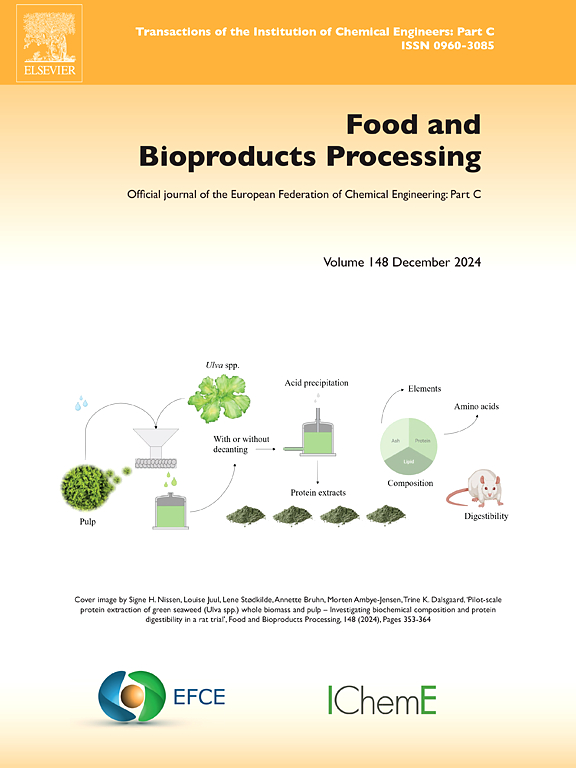Boosting Sacha Inchi valorization through the biorefinery concept in Colombia: Techno-economic assessment
IF 3.4
2区 农林科学
Q2 BIOTECHNOLOGY & APPLIED MICROBIOLOGY
引用次数: 0
Abstract
The conversion of agricultural products into a series of value-added compounds and energy vectors is a key economic driver in emerging industrial countries like Colombia. However, efforts are needed to utilize all biomass sources from the harvest and post-harvest stages. Sacha Inchi (SI) has been categorized as a potential option to promote the bioeconomy through the production of oil and flour. SI waste biomass (e.g., shells and press cake) is often discarded without valorization. This research applies the biorefinery concept to identify the best process setup for improving the techno-economic performance of an existing plant in Colombia. Four biorefinery scenarios were assessed, combining the production of antioxidants, biogas/electricity, and protein. Shells are a good source of antioxidants since shell extracts have a phenolic content of 17.24 mg GAE/g shell. Moreover, Sacha Inchi Oil Press Cake (SIOPC) can produce 29.05 kg of protein/100 kg and 0.52 Nm3 of biogas/kg, respectively. The most effective way to enhance an existing facility is by introducing an antioxidant production line and a bioenergy generation process. Both processing lines require a low capital investment (i.e., 2408,625 USD) with a high payback period (i.e., < 1 year). Antioxidant production is a potential option to be introduced in the existing plant, while protein extraction is not feasible from a techno-economic perspective. The results enabled the elucidation of the reliability and applicability of the biorefinery concept, as profitable processing lines were identified based on techno-economic indicators. Therefore, the biorefinery concept can be applied in any context and at any scale without the need to propose other biotechnological products unrelated to the economic activity of an existing plant (e.g., organic acids, alcohols, and biopolymers). Indeed, food and nutraceutical products align better with the growing use of waste biomass in existing medium-sized enterprises within the food sector.
通过哥伦比亚生物炼制概念促进Sacha Inchi的增值:技术经济评估
将农产品转化为一系列增值化合物和能源载体是哥伦比亚等新兴工业国家的主要经济驱动力。然而,需要努力利用收获和收获后阶段的所有生物质资源。Sacha Inchi (SI)被归类为通过生产油和面粉来促进生物经济的潜在选择。SI废物生物质(例如,贝壳和压饼)通常在没有增值的情况下被丢弃。本研究应用生物炼制概念来确定最佳工艺设置,以提高哥伦比亚现有工厂的技术经济性能。评估了四种生物炼制方案,结合生产抗氧化剂、沼气/电力和蛋白质。由于壳提取物的酚含量为17.24 mg GAE/g壳,因此壳是抗氧化剂的良好来源。此外,Sacha Inchi Oil Press Cake (SIOPC)可分别产生29.05 kg /100 kg和0.52 Nm3 /kg的沼气。改善现有设施的最有效方法是引进抗氧化剂生产线和生物能源生产工艺。两条生产线都需要低资本投资(即2408,625美元),投资回收期高(即1年左右)。抗氧化剂生产是现有工厂的一个潜在选择,而蛋白质提取从技术经济角度来看是不可行的。由于根据技术经济指标确定了有利可图的加工路线,因此结果能够阐明生物精炼厂概念的可靠性和适用性。因此,生物精炼厂的概念可以应用于任何环境和任何规模,而无需提出与现有工厂的经济活动无关的其他生物技术产品(例如,有机酸、醇和生物聚合物)。事实上,食品和营养保健品与食品部门现有中型企业日益增加的废弃生物质利用更加吻合。
本文章由计算机程序翻译,如有差异,请以英文原文为准。
求助全文
约1分钟内获得全文
求助全文
来源期刊

Food and Bioproducts Processing
工程技术-工程:化工
CiteScore
9.70
自引率
4.30%
发文量
115
审稿时长
24 days
期刊介绍:
Official Journal of the European Federation of Chemical Engineering:
Part C
FBP aims to be the principal international journal for publication of high quality, original papers in the branches of engineering and science dedicated to the safe processing of biological products. It is the only journal to exploit the synergy between biotechnology, bioprocessing and food engineering.
Papers showing how research results can be used in engineering design, and accounts of experimental or theoretical research work bringing new perspectives to established principles, highlighting unsolved problems or indicating directions for future research, are particularly welcome. Contributions that deal with new developments in equipment or processes and that can be given quantitative expression are encouraged. The journal is especially interested in papers that extend the boundaries of food and bioproducts processing.
The journal has a strong emphasis on the interface between engineering and food or bioproducts. Papers that are not likely to be published are those:
• Primarily concerned with food formulation
• That use experimental design techniques to obtain response surfaces but gain little insight from them
• That are empirical and ignore established mechanistic models, e.g., empirical drying curves
• That are primarily concerned about sensory evaluation and colour
• Concern the extraction, encapsulation and/or antioxidant activity of a specific biological material without providing insight that could be applied to a similar but different material,
• Containing only chemical analyses of biological materials.
 求助内容:
求助内容: 应助结果提醒方式:
应助结果提醒方式:


